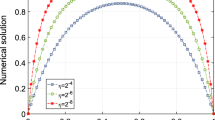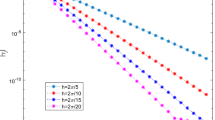Abstract
In this paper, we construct a set of non-polynomial basis functions from a generalised Birkhoff interpolation problem involving the operator: \({\mathscr {L}}_\lambda ={d^2}/{dx^2}-\lambda ^2 \) with constant \(\lambda .\) With a direct inverting the operator, the basis can be pre-computed in a fast and stable manner. This leads to new collocation schemes for general second-order boundary value problems with (i) the matrix corresponding to the operator \({\mathscr {L}}_\lambda \) being identity; (ii) well-conditioned linear systems and (iii) exact imposition of various boundary conditions. This also provides efficient solvers for time-dependent nonlinear problems. Moreover, we can show that the new basis has the approximability to general functions in Sobolev spaces as good as orthogonal polynomials.








Similar content being viewed by others
References
Alpert, B., Greengard, L., Hagstrom, T.: Rapid evaluation of nonreflecting boundary kernels for time-domain wave propagation. SIAM J. Numer. Anal. 37(4), 1138–1164 (2000). (electronic)
Canuto, C., Gervasio, P., Quarteroni, A.: Finite-element preconditioning of G-NI spectral methods. SIAM J. Sci. Comput 31(6), 4422–4451 (2009)
Canuto, C., Quarteroni, A.: Preconditioned minimal residual methods for Chebyshev spectral calculations. J. Comput. Phys. 60(2), 315–337 (1985)
Clenshaw, C.W.: The numerical solution of linear differential equations in Chebyshev series. In: Mathematical Proceedings of the Cambridge Philosophical Society, vol. 53, pp. 134–149. Cambridge Univ Press (1957)
Costabile, F.A., Longo, E.: A Birkhoff interpolation problem and application. Calcolo 47(1), 49–63 (2010)
Coutsias, E., Hagstrom, T., Hesthaven, J.S., Torres, D.: Integration preconditioners for differential operators in spectral \(\tau \)-methods. In: Proceedings of the Third International Conference on Spectral and High Order Methods, Houston, TX, pp. 21–38 (1996)
Coutsias, E.A., Hagstrom, T., Torres, D.: An efficient spectral method for ordinary differential equations with rational function coefficients. Math. Comp. 65(214), 611–635 (1996)
Davis, P.J.: Interpolation and Approximation. Dover Publications Inc, New York (1975)
Deville, M.O., Mund, E.H.: Chebyshev pseudospectral solution of second-order elliptic equations with finite element preconditioning. J. Comput. Phys. 60, 517–533 (1985)
Deville, M.O., Mund, E.H.: Finite element preconditioning for pseudospectral solutions of elliptic problems. SIAM J. Sci. Stat. Comput. 11, 311–342 (1990)
El-Gendi, S.E.: Chebyshev solution of differential, integral and integro-differential equations. Comput. J 12, 282–287 (1969)
Elbarbary, M.E.: Integration preconditioning matrix for ultraspherical pseudospectral operators. SIAM J. Sci. Comput. 28(3), 1186–1201 (2006). (electronic)
Elgindy, K.T., Smith-Miles, K.A.: Solving boundary value problems, integral, and integro-differential equations using Gegenbauer integration matrices. J. Comput. Appl. Math. 237(1), 307–325 (2013)
Ghoreishi, F., Hosseini, S.M.: The Tau method and a new preconditioner. J. Comput. Appl. Math. 163(2), 351–379 (2004)
Greengard, L.: Spectral integration and two-point boundary value problems. SIAM J. Numer. Anal. 28(4), 1071–1080 (1991)
Guo, B.Y., Shen, J., Wang, L.L.: Optimal spectral-Glerkin methods using generalized Jacobi polynomials. J. Sci. Comput. 27(1–3), 305–322 (2006)
Guo, B.Y., Shen, J., Wang, L.L.: Generalized Jacobi polynomials/functions and their applications. Appl. Numer. Math. 59(5), 1011–1028 (2009)
Hesthaven, J.: Integration preconditioning of pseudospectral operators. I. Basic linear operators. SIAM J. Numer. Anal. 35(4), 1571–1593 (1998)
Huang, W., Ma, H., Sun, W.: Convergence analysis of spectral collocation methods for a singular differential equation. SIAM J. Numer. Anal. 41(6), 2333–2349 (2003). (electronic)
Kim, S.D., Parter, S.V.: Preconditioning Chebyshev spectral collocation method for elliptic partial differential equations. SIAM J. Numer. Anal. 33(6), 2375–2400 (1996)
Kim, S.D., Parter, S.V.: Preconditioning Chebyshev spectral collocation by finite difference operators. SIAM J. Numer. Anal. 34(3), 939–958 (1997)
Livermore, P.W.: Galerkin orthogonal polynomials. J. Comput. Phys. 229(6), 2046–2060 (2010)
Lorentz, G.G., Jetter, K., Riemenschneider, S.D.: Birkhoff Interpolation, vol. 19 of Encyclopedia of Mathematics and its Applications. Addison-Wesley Publishing Co., Reading, Mass (1983)
Mihaila, B., Mihaila, I.: Numerical approximations using Chebyshev polynomial expansions: El-Gendi’s method revisited. J. Phys. A 35(3), 731–746 (2002)
Muite, B.K.: A numerical comparison of Chebyshev methods for solving fourth order semilinear initial boundary value problems. J. Comput. Appl. Math. 234(2), 317–342 (2010)
Shen, J.: Efficient spectral-Galerkin method. I. Direct solvers of second- and fourth-order equations using Legendre polynomials. SIAM J. Sci. Comput. 15, 1489–1505 (1994)
Shen, J., Tang, T., Wang, L.L.: Spectral Methods: Algorithms, Analysis and Applications. Series in Computational Mathematics, vol. 41. Springer-Verlag, Berlin (2011)
Shen, J., Wang, L.L.: Fourierization of the Legendre–Galerkin method and a new space-time spectral method. Appl. Numer. Math. 57, 710–720 (2007)
Shen, J., Wang, L.L.: Spectral approximation of the Helmholtz equation with high wave numbers. SIAM J. Numer. Anal. 43(2), 623–644 (2005)
Szegö, G.: Orthogonal Polynomials, 4th edn. AMS Coll. Publ, Providence, RI (1975)
Wang, K., Wong, Y.S., Deng, J.: Efficient and accurate numerical solutions for Helmholtz equation in polar and spherical coordinates. Commun. Comput. Phys. 17(03), 779–807 (2015)
Wang, L.L., Samson, M.D., Zhao, X.D.: A well-conditioned collocation method using a pseudospectral integration matrix. SIAM J. Sci. Comput. 36(3), A907–A929 (2014)
Wang, L.L., Zhang, J., Zhang, Z.: On \(hp\)-convergence of prolate spheroidal wave functions and a new well-conditioned prolate-collocation scheme. J. Comput. Phys. 268, 377–398 (2014)
Wang, L.L., Zhao, X.D., Zhang, Z.: Superconvergence of Jacobi–Gauss-type spectral interpolation. J. Sci. Comput. 59(3), 667–687 (2014)
Weideman, J.A.C., Trefethen, L.N.: The eigenvalues of second-order spectral differentiation matrices. SIAM J. Numer. Anal. 25(6), 1279–1298 (1988)
Zebib, A.: A Chebyshev method for the solution of boundary value problems. J. Comput. Phys. 53(3), 443–455 (1984)
Zhang, Z.: Superconvergence points of polynomial spectral interpolation. SIAM J. Numer. Anal. 50(6), 2966–2985 (2012)
Zheng, X., Dong, S.: An eigen-based high-order expansion basis for structured spectral elements. J. Comput. Phys. 230(23), 8573–8602 (2011)
Author information
Authors and Affiliations
Corresponding author
Additional information
C. Zhang: This work is supported in part by NSF of China N.11571151 and N.11371123, and Priority Academic Program Development of Jiangsu Higher Education Institutions.
L.-L.Wang: The research of this author is partially supported by Singapore MOE AcRF Tier 1 Grants (RG 15/12 and RG 27/15), Singapore MOE AcRF Tier 2 Grant (MOE 2013-T2-1-095, ARC 44/13).
The first two authors would like to thank the hospitality of the Division of Mathematical Sciences, School of Physical and Mathematical Sciences, Nanyang Technological University, Singapore, for hosting their visit. The main part of this work is done during their visit.
Appendices
Formulas for \(C_1\) and \(C_2\) in Proposition 2.1
Corresponding to the typical boundary conditions in (2.3), we have the following formulas for the constant \(C_1\) and \(C_2\) in Proposition 2.1:
-
if \({\mathscr {B}}_\pm [u]=u(\pm 1)=g_\pm ,\) then
$$\begin{aligned} \begin{aligned}&C_1=\frac{1}{2\sinh (2\lambda )}\big \{g_++ {\mathcal {I}}_\lambda ^- [f](1)\big \} -\frac{e^{-2\lambda }}{2\sinh (2\lambda )}\big \{g_-+ {\mathcal {I}}_\lambda ^+ [f](-1)\big \},\\&C_2=-\frac{1}{2\sinh (2\lambda )}\big \{g_++ {\mathcal {I}}_\lambda ^- [f](1)\big \}+\frac{e^{2\lambda }}{2\sinh (2\lambda )}\big \{g_-+ {\mathcal {I}}_\lambda ^+ [f](-1)\big \}\big \}; \end{aligned} \end{aligned}$$(6.1) -
if \({\mathscr {B}}_\pm [u]=u'(\pm 1)=g_\pm ,\) then
$$\begin{aligned} \begin{aligned}&C_1=\frac{\lambda ^{-1}}{2\sinh (2\lambda )}\big \{g_+-\lambda {\mathcal {I}}_\lambda ^- [f](1)\big \} -\frac{\lambda ^{-1}e^{-2\lambda }}{2\sinh (2\lambda )}\big \{g_-+\lambda {\mathcal {I}}_\lambda ^+ [f](-1)\big \},\\&C_2=\frac{\lambda ^{-1}}{2\sinh (2\lambda )}\big \{g_+-\lambda {\mathcal {I}}_\lambda ^- [f](1)\big \} -\frac{\lambda ^{-1}e^{2\lambda }}{2\sinh (2\lambda )}\big \{g_-+\lambda {\mathcal {I}}_\lambda ^+ [f](-1)\big \};\\ \end{aligned} \end{aligned}$$(6.2) -
if \({\mathscr {B}}_- [u]=u(-1)=g_-\) and \({\mathscr {B}}_+ [u]=u'(1)+ \eta \, u(1)=g_+,\) then
$$\begin{aligned} \begin{aligned}&C_1=\frac{ g_++(\eta -\lambda ) {\mathcal {I}}_\lambda ^- [f](1)}{2\big (\lambda \cosh (2\lambda ) +\eta \sinh (2\lambda )\big )}- \frac{(\eta -\lambda ) e^{-2\lambda }\big \{g_- +{\mathcal {I}}_\lambda ^+ [f](-1)\big \}}{2\big (\lambda \cosh (2\lambda ) +\eta \sinh (2\lambda )\big )},\\&C_2=-\frac{g_++(\eta -\lambda ) {\mathcal {I}}_\lambda ^- [f](1)}{2\big (\lambda \cosh (2\lambda ) +\eta \sinh (2\lambda )\big )}+ \frac{(\eta +\lambda ) e^{2\lambda }\big \{g_- +{\mathcal {I}}_\lambda ^+ [f](-1)\big \}}{2\big (\lambda \cosh (2\lambda ) +\eta \sinh (2\lambda )\big )}. \end{aligned} \end{aligned}$$(6.3)
Jacobi Polynomials and Jacobi–Gauss–Lobatto Quadrature
Let \(P_n^{(\alpha ,\beta )}(x) \) (\(x\in [-1,1] \) and \(\alpha ,\beta >-1\)) be the Jacobi polynomial of degree n, as normalized in [30]. We also refer to [30] for the following basic properties.
The Jacobi polynomials are eigenfunctions of the Sturm-Liouville equation
where the corresponding eigenvalues are
The Jacobi polynomials are orthogonal with respect to the Jacobi weight function: \(\omega ^{(\alpha ,\beta )}(x) = (1-x)^{\alpha }(1+x)^{\beta },\) namely,
where \(\delta _{nn'}\) is the Dirac Delta symbol, and the normalization constant is given by
We have
Moreover, there holds the important derivative formula:
We also use the following recurrent relation:
where \(a_1:=a_1^{(\alpha ,\beta )}=0\), and
The Jacobi–Gauss–Lobatto (JGL) points \(\big \{x_j=\xi _{N,j}^{(\alpha ,\beta )}\big \}_{j=0}^N\) (with \(x_0=-1, x_N=1)\) are zeros of \((1-x^2) \partial _x P_{N}^{(\alpha ,\beta )}(x).\) Let \(\big \{\omega _j=\omega _{N,j}^{(\alpha ,\beta )}\big \}_{j=0}^N\) be the corresponding JGL quadrature weights (cf. [27, Theorem. 3.27]). Then we have
Let \(\big \{h_j:=h_{N,j}^{(\alpha ,\beta )}\big \}\) be the Lagrange interpolating basis polynomials associated with \(\{x_j\}_{j=0}^{N},\) such that \(h_j\in {\mathcal {P}}_{N}\) and \(h_j(x_i)=\delta _{ij}.\) We have the representation
where
Let \({\mathbb {I}}_N\) be the corresponding Lagrange interpolation operator, namely, \({\mathbb {I}}_N: C(\bar{\Lambda })\rightarrow {\mathcal {P}}_N\) such that for any \(u\in C(\bar{\Lambda }),\)
Proof of Proposition 3.3
By the orthogonality (7.3) and (7.9),
where we used the property: \(l_j(x_i)=\delta _{ij}\) for \(1\le i,j\le N-1\) (cf. (2.7)). Thus, it remains to derive the explicit formulas for \(l_j(\pm 1).\) As the interior JGL points \(\{x_j\}_{j=1}^{N-1}\) are zeros of \(\partial _xP_N^{(\alpha ,\beta )}(x),\) we have
By (7.1),
A direct calculation from (8.2) and (8.3) leads to
Thus, we obtain the desired formulas of \(l_j(\pm 1)\) in (3.6).
Rights and permissions
About this article
Cite this article
Zhang, C., Liu, W. & Wang, LL. A New Collocation Scheme Using Non-polynomial Basis Functions. J Sci Comput 70, 793–818 (2017). https://doi.org/10.1007/s10915-016-0269-7
Received:
Revised:
Accepted:
Published:
Issue Date:
DOI: https://doi.org/10.1007/s10915-016-0269-7




